Services on Demand
Journal
Article
Indicators
-
 Cited by SciELO
Cited by SciELO -
 Access statistics
Access statistics
Related links
-
 Cited by Google
Cited by Google -
 Similars in
SciELO
Similars in
SciELO -
 Similars in Google
Similars in Google
Share
DYNA
Print version ISSN 0012-7353On-line version ISSN 2346-2183
Dyna rev.fac.nac.minas vol.79 no.171 Medellín Jan./Feb. 2012
STRUCTURAL, MAGNETIC, MULTIFERROIC, AND ELECTRONIC PROPERTIES OF SR2TIMNO6 DOUBLE PEROVSKITE
PROPIEDADES ESTRUCTURALES, MAGNÉTICAS, MULTIFERRÓICAS, Y ELECTRÓNICAS DE LA DOBLE PEROVSKITA SR2TIMNO6
DAVID LANDÍNEZ-TÉLLEZ
PhD., Departamento de Física, Universidad Nacional de Colombia, Bogotá, dalandinezt@unal.edu.co
GABRIEL PEÑA-RODRÍGUEZ
PhD., Universidad Francisco de Paula Santander, Cúcuta, ggabrielp@yahoo.com
FABIO FAJARDO
PhD., Departamento de Física, Universidad Nacional de Colombia, Bogotá, fefajardot@unal.edu.co
JAIRO ARBEY RODRÍGUEZ M.
PhD., Departamento de Física, Universidad Nacional de Colombia, Bogotá, jarodriguezm@unal.edu.co
JAIRO ROA-ROJAS
PhD., Departamento de Física, Universidad Nacional de Colombia, Bogotá, jroar@unal.edu.co
Received for review March 20th, 2011, accepted November 17th, 2011, final version November, 23th, 2011
ABSTRACT: We report structural analysis, magnetic ordering, ferroelectric behavior, and the electronic structure of SR2TIMNO6 complex perovskite. Samples were produced by the solid state reaction recipe. Crystallographic analysis was performed by Rietveld refinement of experimental X-ray diffraction patterns. Results show that this material crystallizes in a perovskite tetragonal structure which corresponds to the space group I4/mmm. We obtain a matching of 99% between structural properties predicted by the density functional theory and structural ordering, found from the Rietveld refinement method. From field cooling measurements of susceptibility as a function of temperature, we determine the occurrence of a magnetic ordering for a critical temperature of 44.8 K. From a fitting with the molecular field theory of ferrimagnetism, we establish that the ordering corresponds to a paramagnetic-ferrimagnetic transition, which is corroborated by the behavior of the inverse of susceptibility as a function of temperature. The Curie constant allowed for us to obtain an effective magnetic moment of 3.5 mB. The result of magnetization as a function of the applied field, measured at T = 40 K, shows a ferromagnetic-hysteretic behavior. The curve of polarization as a function of applied voltage evidences a ferroelectric character. It is shown experimentally that below 44.8 K this perovskite material evidences a multiferroic feature. Ab initio calculations of density of states and band structure for this manganite-like material were carried out by means of the density functional theory (DFT) and the linearized augmented plane waves method for both spin orientations. For calculations, the exchange and correlation potentials were included through the local density LDA+U approximation. The density of states study was carried out considering both up and down spin polarizations by the generalized gradient approximation (GGA). Results of total and partial density of states reveal the insulator character of this material with an effective magnetic moment of 3.3 mB.
KEYWORDS: complex perovskite, magnetic properties, electronic structure
RESUMEN: En este trabajo reportamos el análisis estructural, ordenamiento magnético, carácter ferroeléctrico y estructura electrónica de la perovskite compleja SR2TIMNO6. Las muestras fueron producidas mediante reacción de estado sólido. El análisis cristalográfico fue realizado a través de refinamiento Rietveld de los patrones experimentales de rayos x. Los resultados muestran que este material cristaliza en una perovskita tetragonal correspondiente al grupo espacial I4/mmm. Hemos obtenido un acuerdo del 99% entre las propiedades estructurales predichas por la teoría del funcional de la densidad y el ordenamiento estructural determinado mediante refinamiento Rietveld. A través de medidas de susceptibilidad en función de la temperatura encontramos ordenamiento magnético para una temperatura crítica de 44.8 K. Por medio del ajuste con la teoría molecular de ferrimagnetismo establecimos que el ordenamiento magnético se relaciona con una transición paramagnético-ferrimagnético, la cual se corrobora por el comportamiento del inverso de la susceptibilidad en función de la temperatura. La constante de Curie permitió determinar un momento magnético efectivo de 3.5 mB. Medidas de magnetización en función del campo aplicado a T = 40 K, muestra un comportamiento histerético. La curva de polarización en función del campo eléctrico evidencia una característica ferroeléctrica. Experimentalmente se demuestra que el material se comporta como un multiferróico. Cálculos Ab initio de la densidad de estados fueron realizados por medio de la teoría de funcional densidad y del método ondas planas aumentadas linealizadas para orientaciones de espín arriba y abajo. Los cálculos de intercambio y potencial de correlación fueron incluidos a través de la aproximación de densidad local LDA+U. Los resultados de la densidad de estados muestran la característica aislante de este material con un momento magnético efectivo de 3.3mB.
PALABRAS CLAVE: perovskita compleja, propiedades magnéticas, estructura electrónica
1. INTRODUCTION
In recent years, many studies of perovskite ceramics have been carried out with the objective of finding materials that show coupled magnetic and electric properties for applications in the magnetoelectronics technology such as non-volatile memories [1-5]. These materials that combine spontaneous magnetization and spontaneous ferroelectric polarization have been called multiferroics [6]. The mechanisms that produce the interaction between electric and magnetic order parameters are not yet established absolutely; nevertheless, there is great interest in the study of the magnetoelectric materials because the introduction of an additional degree of freedom gives us the possibility of manipulating multifunctional devices through more than one physical field. Particularly, coupling between ferroelectric and ferromagnetic order parameters opens the perspective to tune syntonize the magnetization response of magnetoelectric material by means of an applied electric field, and vice versa. In order to investigate the possibility of assembling a magnetoelectric system from simple perovskites which evidence dielectric and magnetic behaviors such as srtio3 and srmno3, respectively [7,8], we propose the SR2TIMNO6 (STMO) manganite-like material. In this paper we present the synthesis and characterization of STMO. We found that this material belongs to the complex perovskite family. Magnetic measurement results show the ferrimagnetic feature of STMO. Polarization hysteresis curves evidence the ferroelectric character of the material. Electronic structure calculations performed by the DFT reveal that material evidences a semiconductor feature.
2. EXPERIMENTAL SET-UP
The samples were synthesized by the solid state reaction recipe. The precursor powders SrO, TiO2, and MnO2 (Aldrich 99.9%) were stoichiometrically mixed according to the chemical formula SR2TIMNO6. The mixture was ground to form a pellet and annealed at 1250 ºC for 12 h. The samples were then ground again, repelletized, and sintered at 1250 ºC for 24 h and at 1350 ºC for 24 h. An X-ray diffraction (XRD) experiment was performed by means of a pw1710 diffractometer with λcuka = 1.54064 Å. The Rietveld refinement of the diffraction pattern was made by the GSAS code [9]. Field cooling (FC) measurements of susceptibility as a function of temperature and magnetization as a function of applied field were carried out by using an MPMS Quantum Design squid. Electric polarization curves were measured by means of a Radiant Ferroelectric Tester, which includes a ±10 kV source for experiments in bulk samples.
3. CALCULATION METHOD
The density functional theory [10,11] is an efficient and accurate method to obtain the solution of the many-electron problem of a crystal, and the Wien2k code has a good performance for resolving it [12]. We have employed it with the generalized gradient approximation, GGA [13] to obtain the structural and electronic properties of the STMO perovskite. All calculations were carried out using spin polarization. The space group used was #139 (I4/mmm), which is a tetragonal group with 16 symmetry operations. Muffin-tin radii used for Sr, Ti, Mn, and O were, 1.16 Å, 1.01 Å, 1.01 Å, and 0.89 Å, respectively; RMT-Kmax= 8.00, maximum angular momentum l = 10, gmax= 14.0, and k-points number in the irreducible part of the First Brillouin Zone (FBZ) was 288. The first calculation consisted in the determination of best structural parameters. The second one was the calculation of electronic and magnetic properties using the structural results. The convergence parameter for energy variations was set up as 0.0001 Ry.
4. RESULTS AND DISCUSSION
The analysis of the XRD pattern showed in Fig. 1 reveals the presence of characteristic peaks of complex perovskite systems. In Fig. 1, crosses represent the experimental data and lines correspond to the pattern simulated by means of the GSAS code. The base line is the difference between theoretical and experimental results.
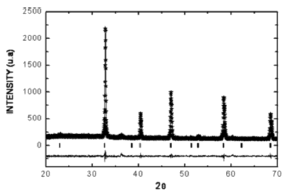
Figure 1. Characteristic XRD pattern for the complex perovskite STMO. Symbols represent experimental diffraction data, and the base line is the difference between experimental and simulated patterns (continuous line).
Rietveld refinement allowed for us to establish that this material crystallizes in a tetragonal double perovskite with space group I4/mmm (#139) and lattice parameters a = 5.4858 Å and c = 7.7518 Å. These results are 99.78% in agreement with the theoretical values obtained from the Structure Prediction Diagnostic Software SPuDS [14], which predicts that lattice constants are a = 5.4702 Å and c = 7.7361 Å for the STMO material.
Magnetic properties of STMO have ben investigated by measuring the DC susceptibility in the temperature range from 5 to 200 K and at an applied magnetic field of 100 Oe. Figure 2 shows the dependence of susceptibility as a function of temperature for STMO when it is measured using the field cooling recipe. In the inset of Fig. 2 the inverse of susceptibility reveals a non-linear behavior with temperature, which is a characteristic of ferrimagnetic materials [15].
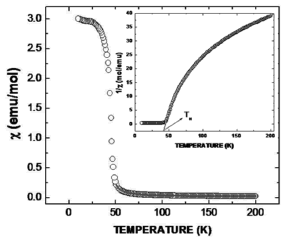
Figure 2. The magnetic behavior of STMO obtained from measurements of susceptibility as a function of temperature. The inset shows the behavior of the inverse of susceptibility. The fittings of c and 1/c were made by the MFTF.
The fitting of both susceptibility and reciprocal of susceptibility as a function of temperature was made by the molecular field theory of ferrimagnetism (MFTF) [164],

which allowed for us to establish the Néel temperature TN = 44.8 K, the Curie constant C = 1.5349 emu.K/mol, and a susceptibility independent of temperature 1.9 x 10-3 emu/mol. From the Curie constant we obtain the effective magnetic moment of material m = 3.5mB. This value is low when compared with the Mn4+ isolated cation, calculated from Hund's rule. The hysteresis curve of magnetization as a function of an applied field, measured at T = 40 K (Fig. 3), evidences a ferromagnetic-like ordering. From the saturation magnetization (» 135 emu/cm3) and the experimental lattice parameters, we have determined that the effective magnetic moment close and below the Néel temperature is m = 3.4 mB, which is in agreement with the value obtained from the MFTF.
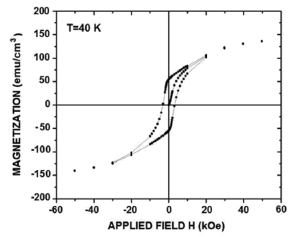
Figure 3. Hysteretic ferromagnetic behavior of magnetization as a function of applied magnetic field for the STMO measured at T = 40 K < TN
Measurements of polarization as a function of applied voltage (Fig. 4) were performed in order to establish the multiferroic behavior of STMO material.
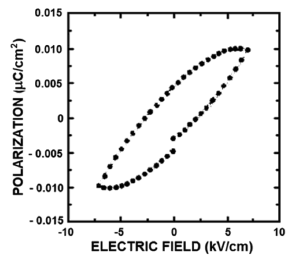
Figure 4. Hysteretic ferroelectric feature of polarization as a function of electric field for STMO
Figure 5 shows the optimization of energy as a function of volume and c/a factor (a and c are the lattice constants). The difference between the two minimals is less than the convergence parameter. The minimal for the energy as a function of volume was obtained adjusting Murnaghan's state equation to the square points [17]. The structural parameter values that minimize the energy are a = 5.508(2) Å and c = 7.792(8) Å. The lattice parameters obtained from Murnaghan's state equation are more than 99% in agreement with our experimental results.
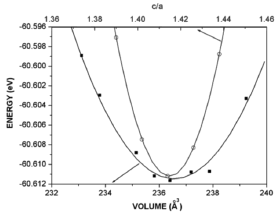
Figure 5. Calculated total energy as a function of volume and c/a factor for the STMO material
Figure 6 shows the calculated total and partial density of states due to the d-like atomic orbital of an Mn atom. For the total magnetic moment, the x2 - y and xy + yz, like the Mn atomic orbital, are the most important. Below the Fermi level, the xy and the z2-like Mn atomic orbital are more symmetric with respect to spin orientation than the former ones. Consequently, the contribution of these orbitals to the magnetic moment is not significant. The total calculated magnetic moment was 3.3 mB, which is in good agreement with the experimental results. For both up and down polarization, the STMO presents a semiconductor characteristic with an energy gap of 1.2 eV.
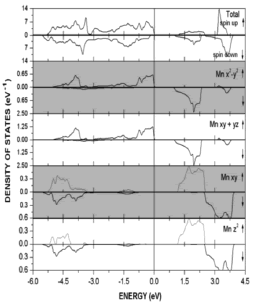
Figure 6. Total and partial density of states for the SR2TIMNO6 material. The figure only shows the most interesting Mn partial contributions. The Fermi level is the energy reference.
5. CONCLUSIONS
The synthesis and structural characterization of new SR2TIMNO6 manganite-like material was performed. Rietveld analyses reveal that this material crystallizes in a tetragonal complex perovskite which corresponds to an I/4mmm space group. Measurements of magnetic susceptibility showed a ferrimagnetic ordering transition for a TN = 44.8 K, which was fitted by the MFTF. The ferroelectric behavior of the system was examined by means of polarization hysteretic curves. From the minimization of energy as a function of volume, we obtained lattice parameters, which are ~ 99% in agreement with experimental data. The density of states results give evidence that this complex perovskite behaves as a semiconductor material. The experimental and theoretical cell magnetic moment supplies the value of m = 3.4mB. Our results allow for us to infer that it is possible to produce multiferroic complex perovskites from the mixture of ferroelectric and ferromagnetic simple perovskites.
ACKNOWLEDGMENTS
This work was partially supported by the División de Investigaciones Sede Bogotá (DIB) of the Universidad Nacional de Colombia.
REFERENCES
[1] V.R. Palkar, S.K. Malik, Solid State Commun., 134, 783 (2005). [ Links ]
[2] J. Wang, J. B., Neaton, H., Zheng, V., Nagarajan, S. B., Ogale, B., Liu, D., Viehland, V., Vaithyanathan, D. G., Schlom, U. V., Waghmare, N.A., Spaldin, K.M., Rabe, M., Wuttig, and Ramesh, R., Science 299, 1719 2003. [ Links ]
[3] Kimura, T., Goto, T., Shintani, H., Ishizaka K., Arima, T. and Tokura Y., Nature 426, (55) 2003. [ Links ]
[4] Landinez Tellez, D.A., Peña Rodríguez, G., and Roa Rojas, J., Dyna, year 77., Nro. 163, pp 234-238, 2010 [ Links ]
[5] Fuentes Guerrero, U., Parra Vargas, C, and Sarmiento Santos, A., Dyna, año 78, Nro. 169, pp. 201-205, 2011 [ Links ]
[6] P. Baettig, N.A. Spaldin, Appl. Phys. Lett., 86, 12505 2005. [ Links ]
[7] C. Ang, R., Guo, A.S., Bhalla, L.E., Cross, J., of Appl. Phys87, 3937 2000. [ Links ]
[8] Chamberland, B.L., Sleight, A.W., Weiher, J J.F., of Solid State Chem., 1, 506 (1970). [ Links ]
[9] Larson, A. C., Von, R. B., Dreele, General Structure Analysis System (GSAS), Los Alamos National Laboratory Report LAUR, pp. 86-748, 2000 [ Links ]
[10] Hohenberg, P., Khon, W., Phys. Rev., 136, B864 1964. [ Links ]
[11] Khon, W., Sham, L. S., Phys. Rev., 140, A1133 1965. [ Links ]
[12] Blaha, P., Schwarz, K., Madsen, G. K. H., Kvasnicka, D. and Luitz J., WIEN2k, An Aug-mented Plane Wave + Local Orbitals Program for Calculating Crystal Properties, Karlheinz Schwarz, Techn. UniversitÄat Wien, Austria 2001, ISBN 3-9501031-1-2. [ Links ]
[13] Perdew, J.P., Burke, K., Ernzerhof, M., Phys. Rev. Lett., 77, 3865 1996. [ Links ]
[14] Lufaso, M.W., Woodward, P.M., Acta Cryst. B57, 725 2001. [ Links ]
[15] Kittel, C., "Introduction to Solid State Physics", 8th Ed. University of California, Berkeley 2005. [ Links ]
[16] Cullity, B.D., Graham, C.D., "Introduction to Magnetic Materials", 2nd Ed., IEEE Press, NJ, 2009. [ Links ]
[17] Bonilla, C.M., Landínez Téllez, D.A., Rodríguez, E J. Arbey., Vera-López, J. Roa-Rojas, Physica B, 398, 208 2007 [ Links ]














